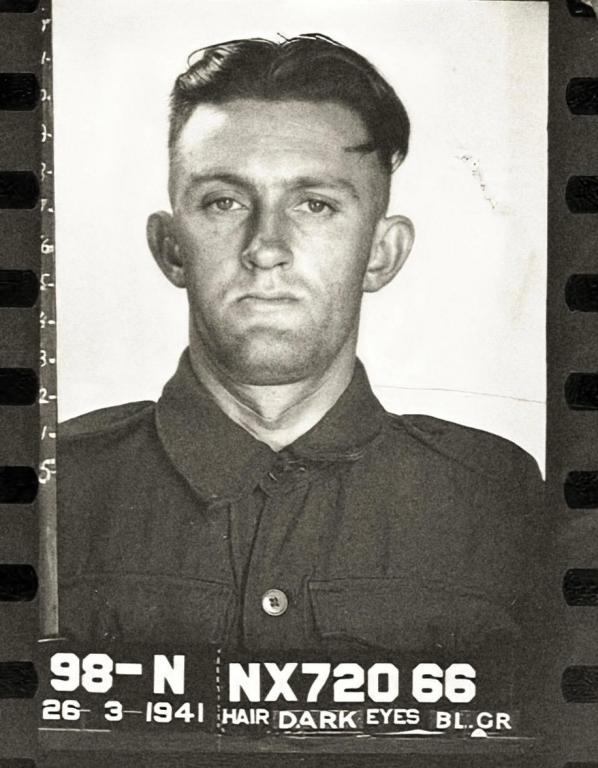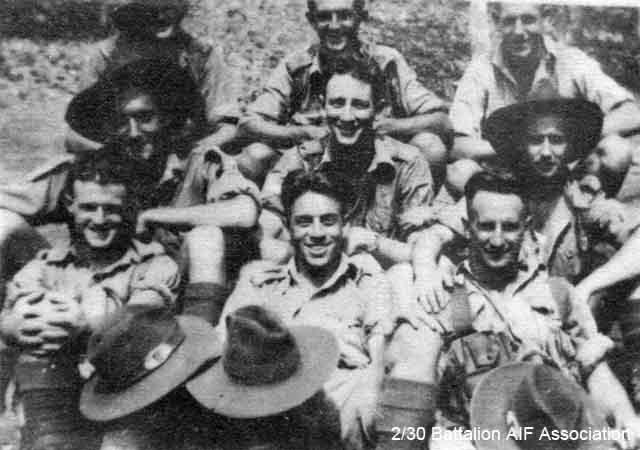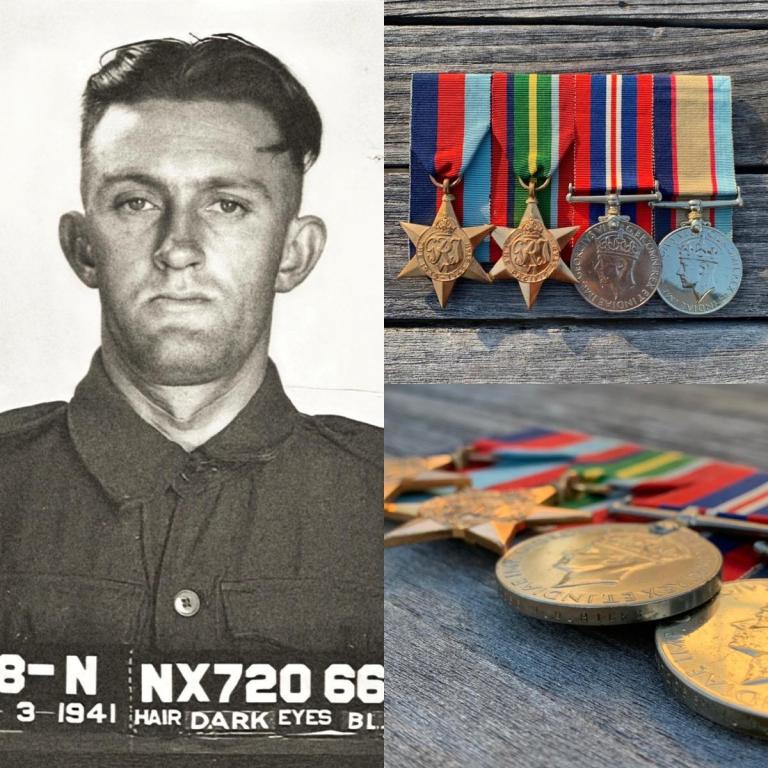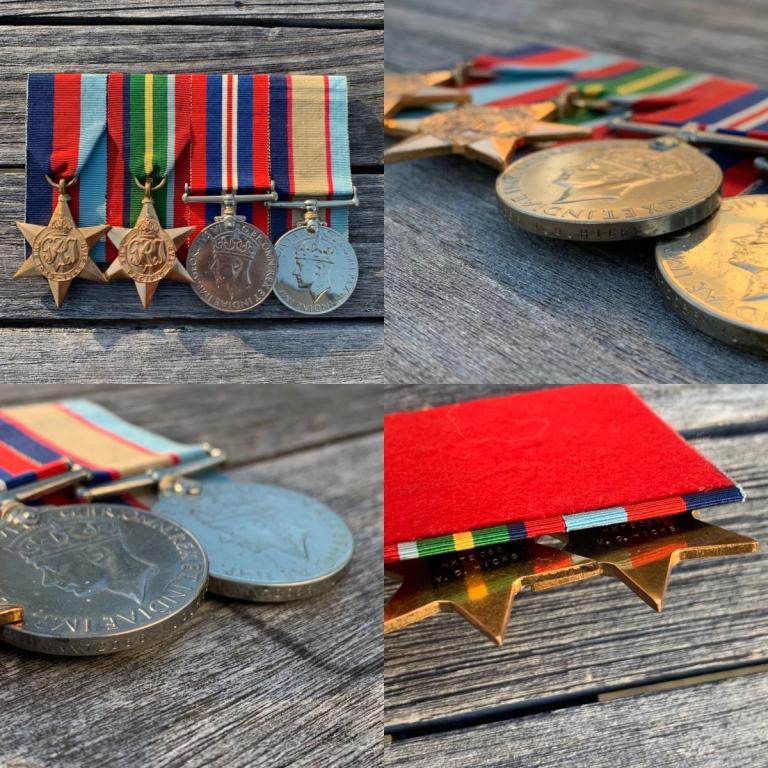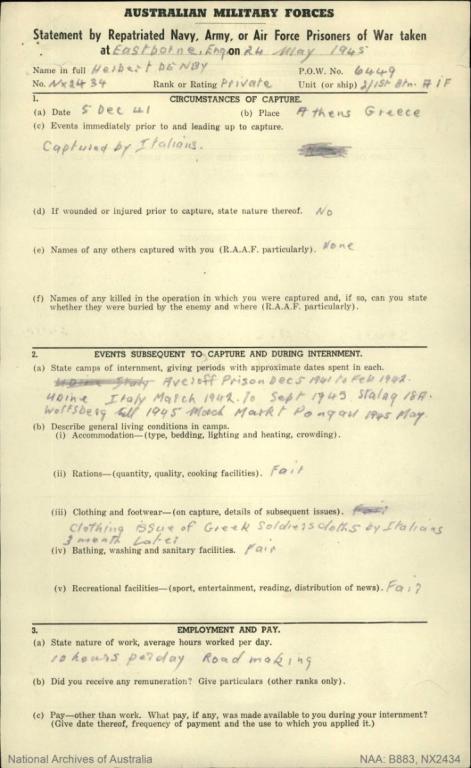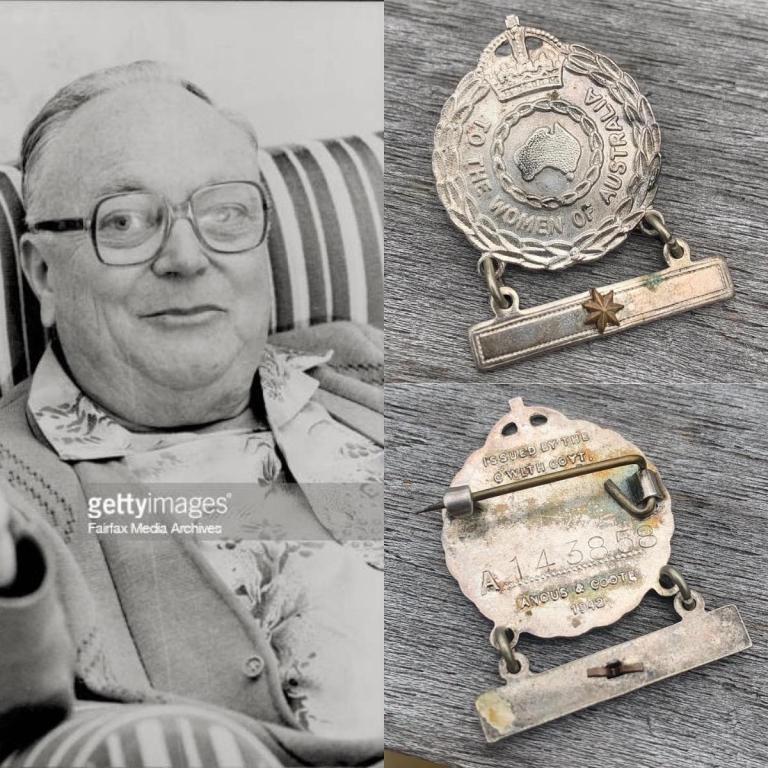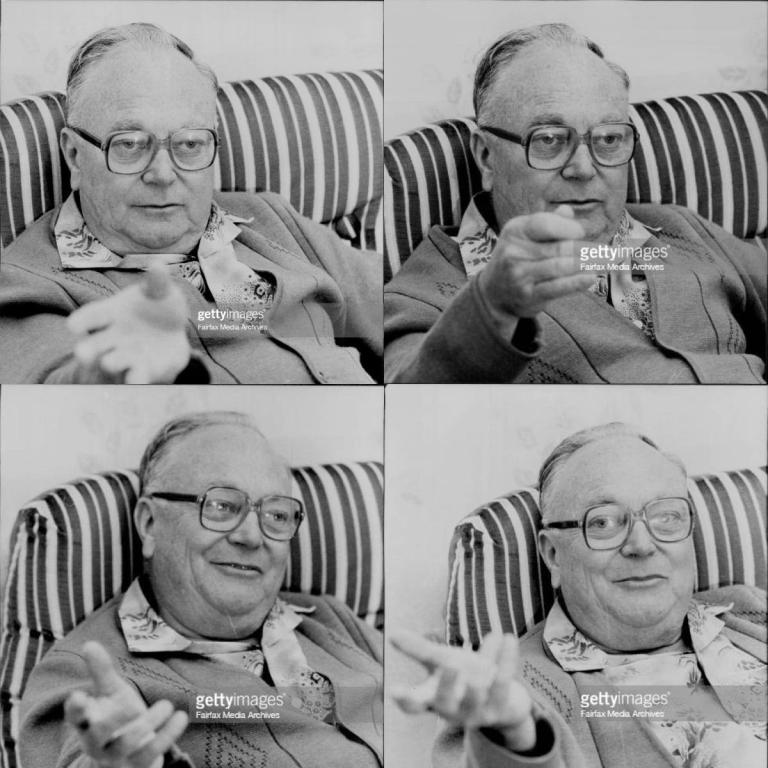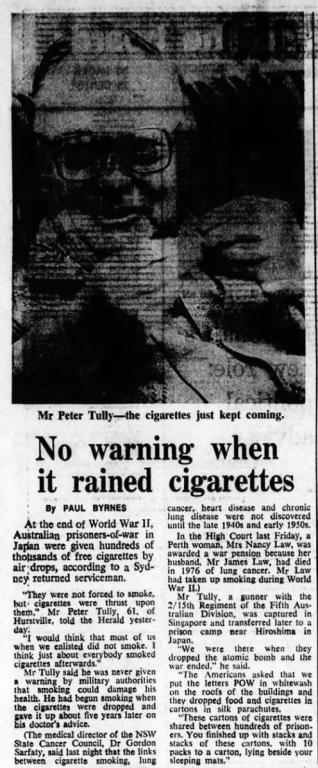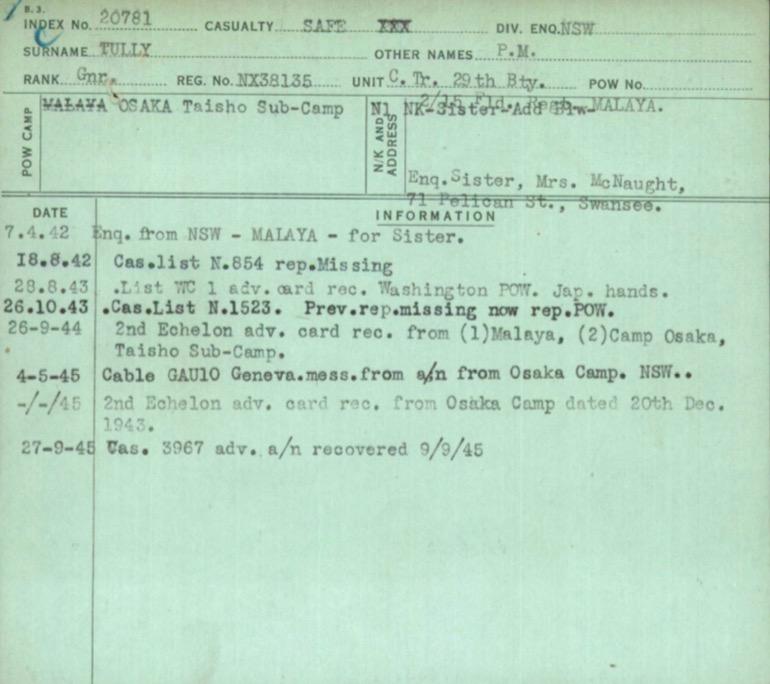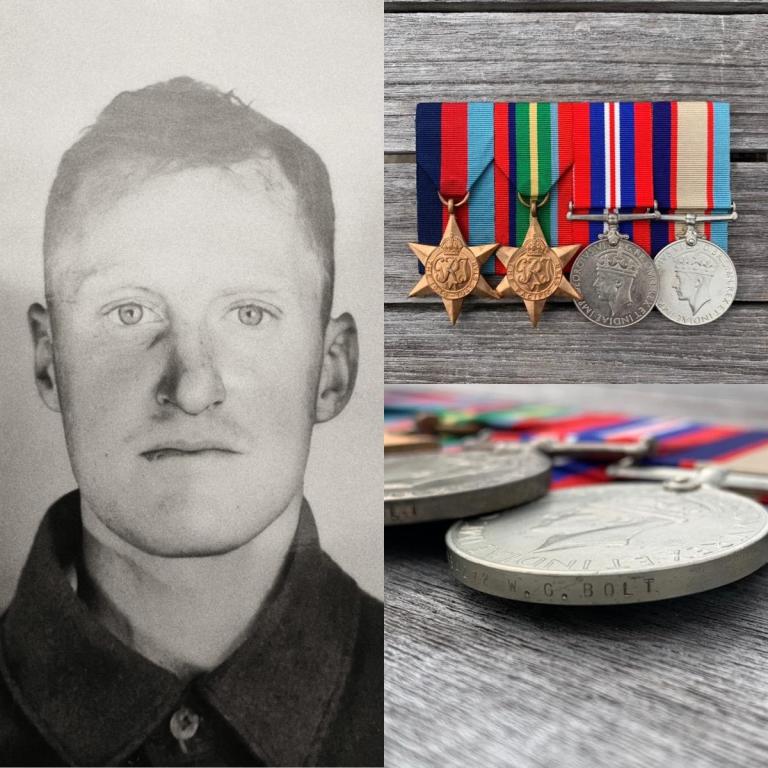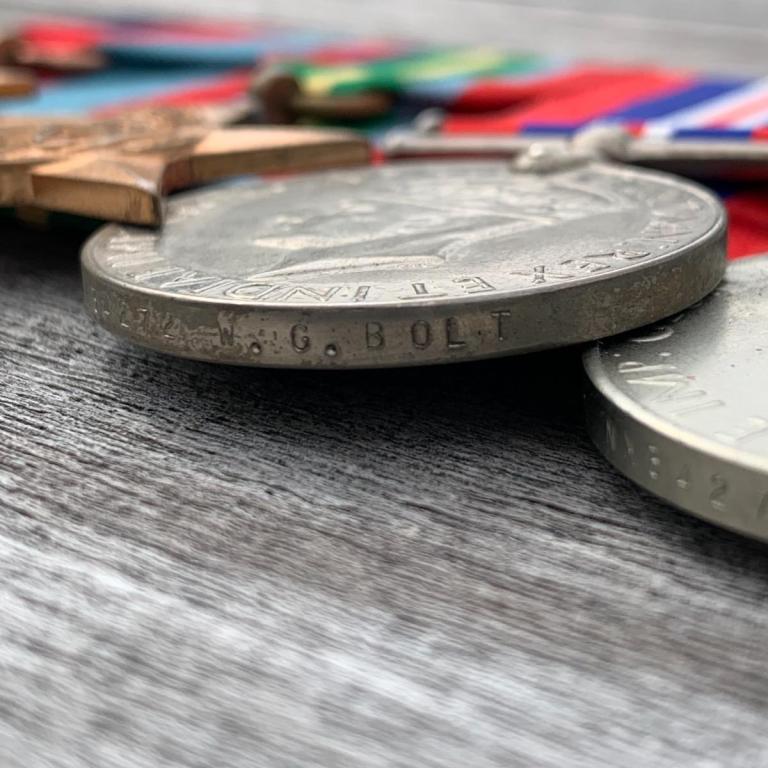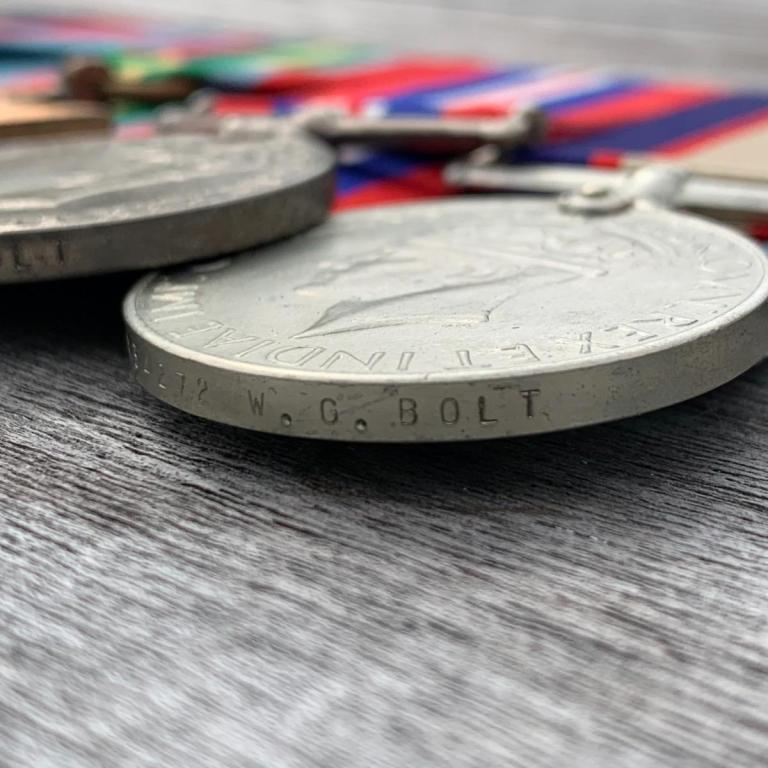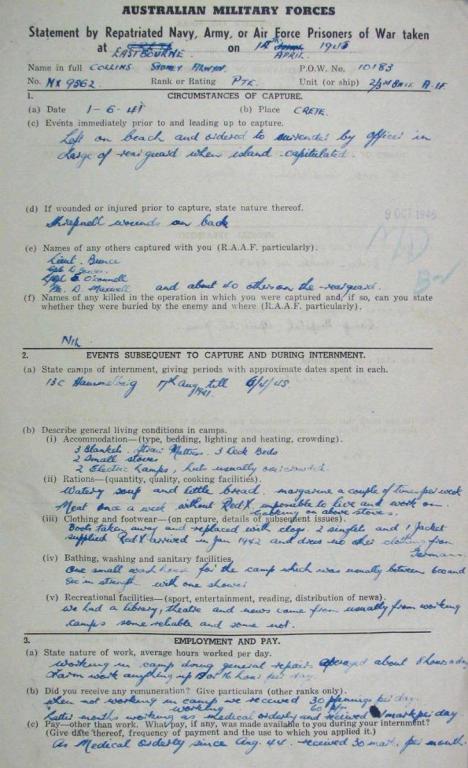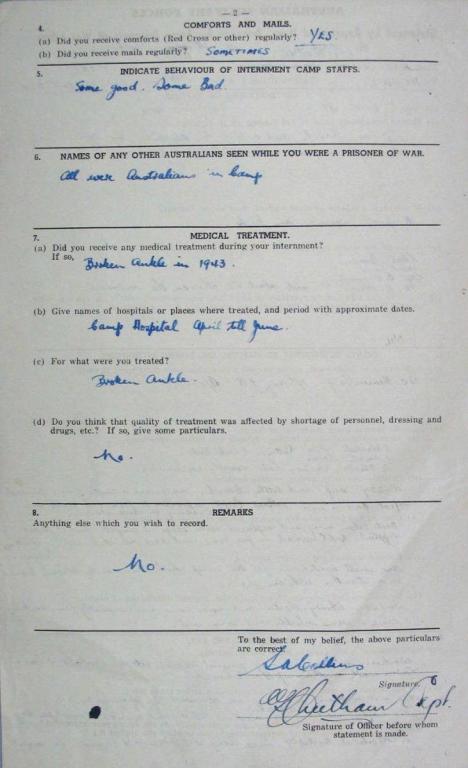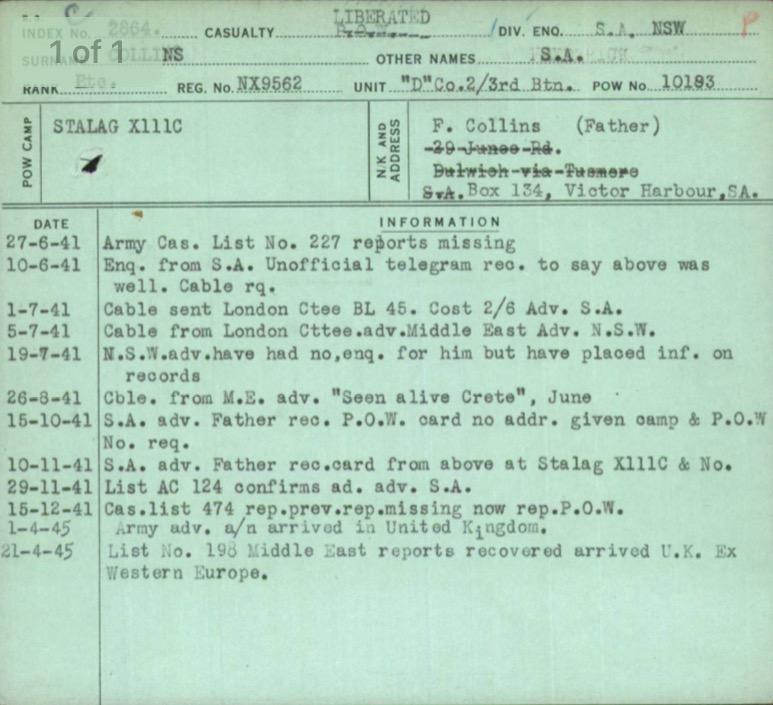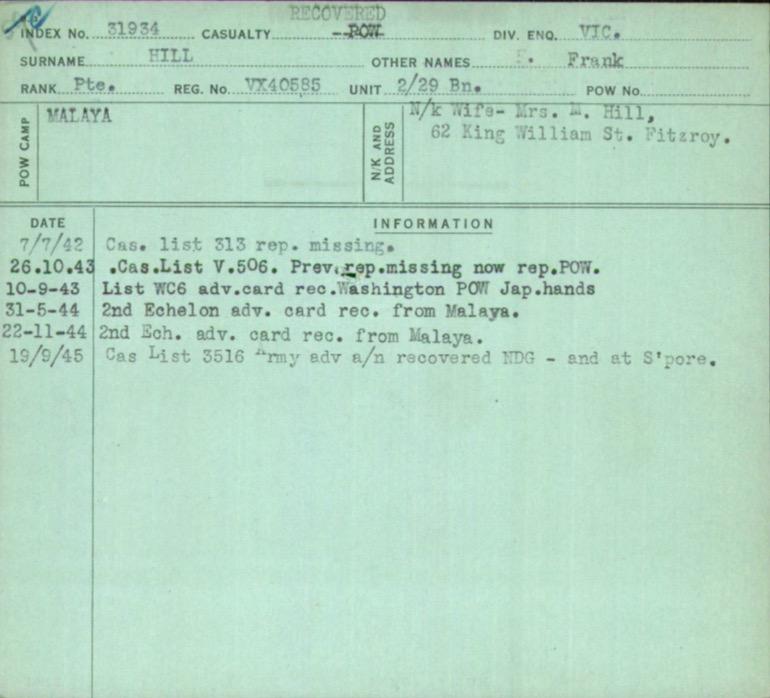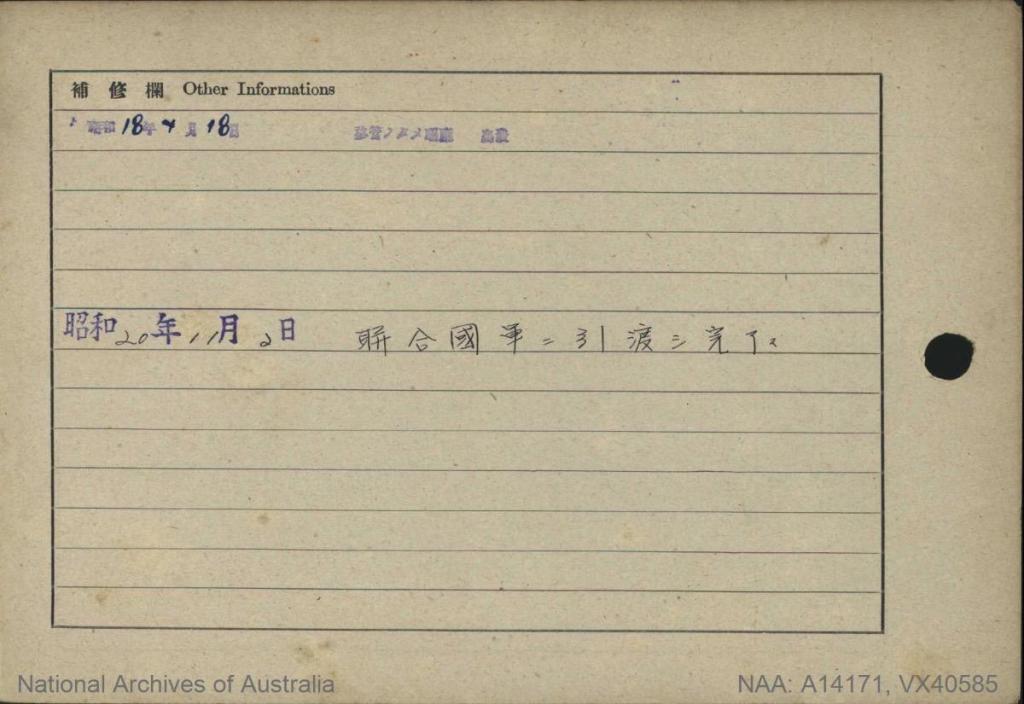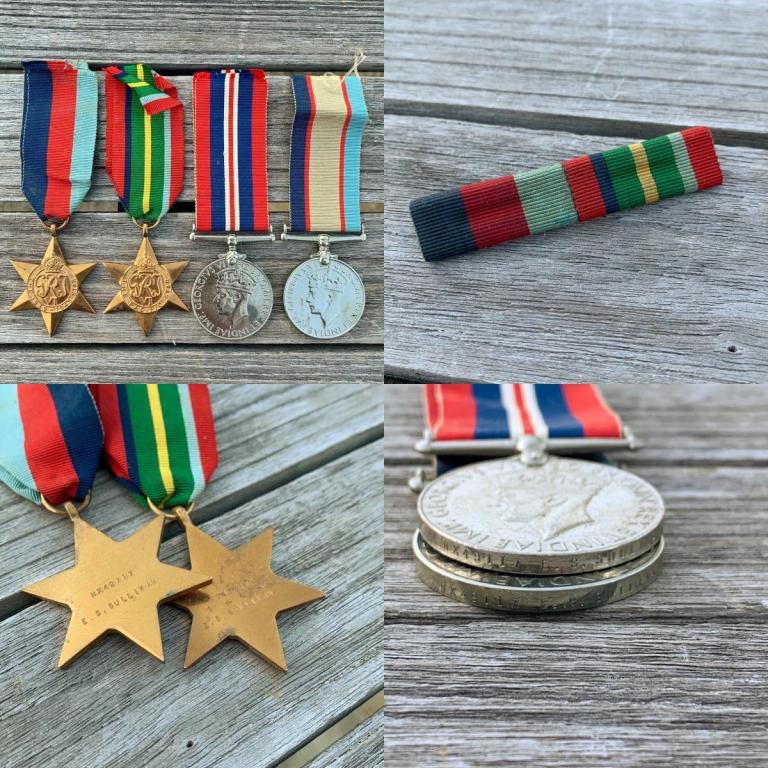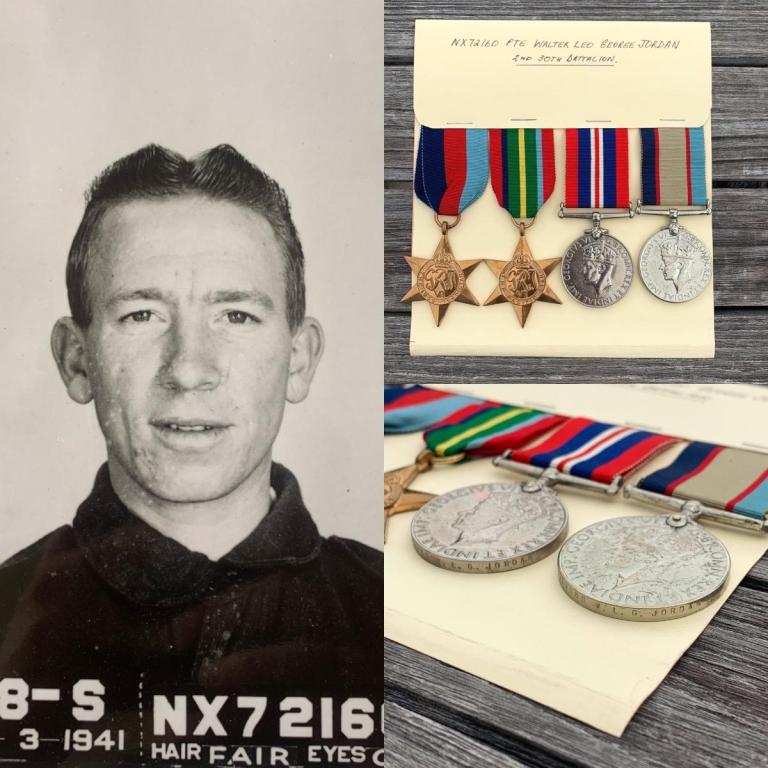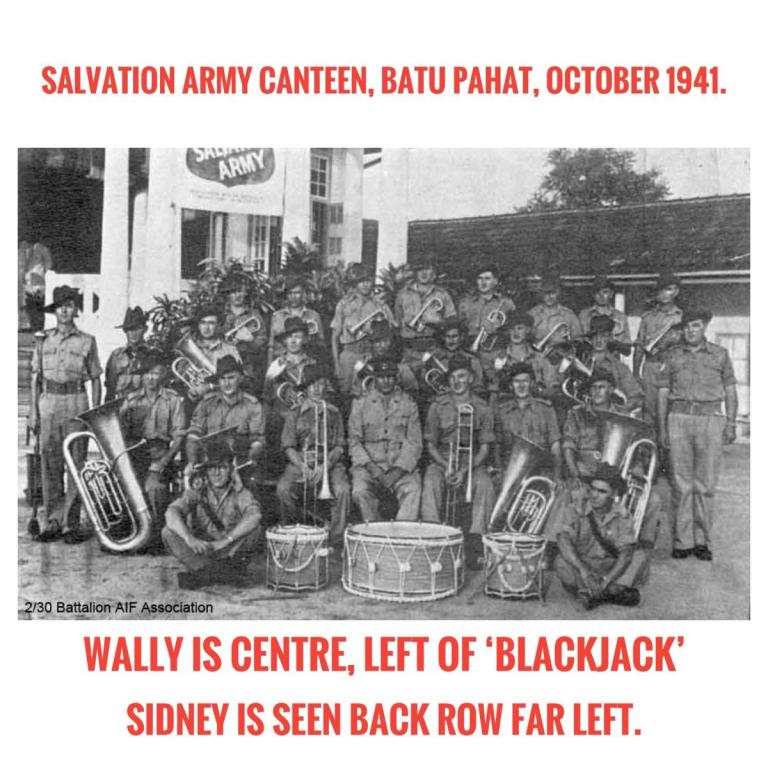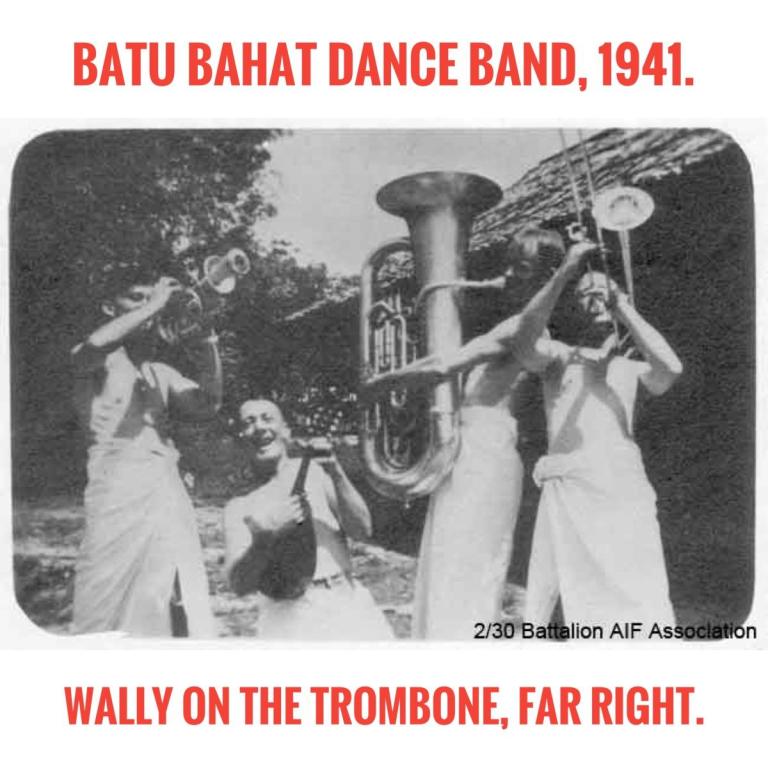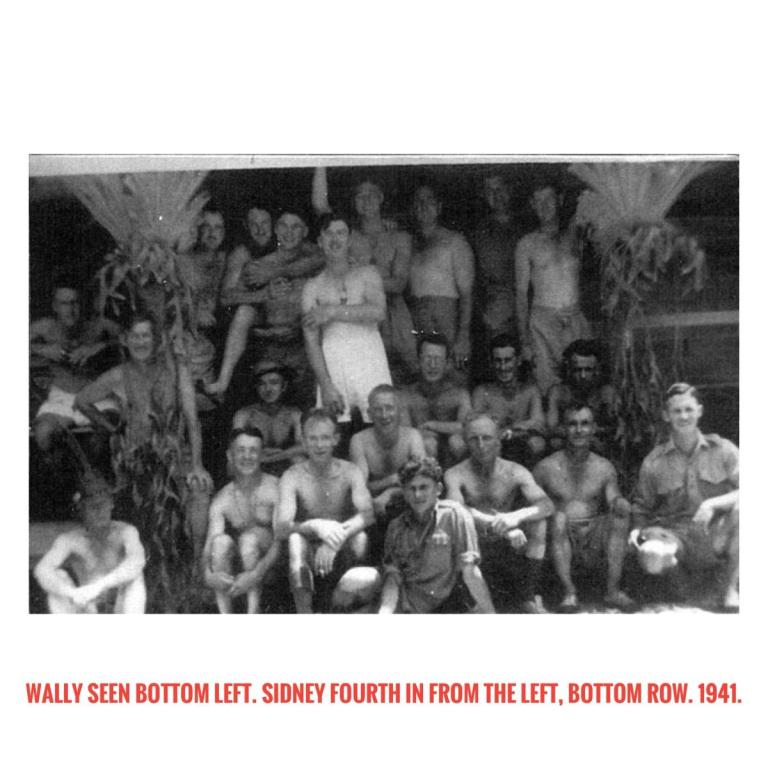-
Posts
16 -
Joined
-
Last visited
Content Type
Profiles
Forums
Blogs
Gallery
Events
Store
Everything posted by BustersPOWs
-

My Australian POW Collection
BustersPOWs replied to BustersPOWs's topic in Great Britain: Orders, Gallantry, Campaign Medals
G’day to everyone, my apologies about the absence, as often is the case. The real world takes over and I’ve been busy with work and university! However I have still actively been buying and have some stories to share with you all! Today we have: NX72066, Private Vernon ‘Tiny’ Owen Hicks of the 2/30th Battalion, who fought through Malaya, became a POW and sent to Sandakan in Borneo where in 1945, he participated in the infamous Sandakan Death Marches. Vernon Owen Hicks was born on the 31st of August 1916 in the Northern NSW town of Bonalbo. Up until his enlistment into the 2nd AIF, Vernon worked as a labourer. Upon his enlistment on the 26th March 1941 he was absorbed into the 2nd Reinforcements of the 2/30th Battalion, falling into B Company, 12 Platoon, Section 8. Following a short few months of training Vernon and the rest of the 2/30th joined the 27th Brigade, under the banner of the 8th Division and sailed for the Malayan Peninsula on the 29th of July 1941. For many of these men it would be the last time they waved goodbye to Sydney Harbour. In Malaya the 2/30th set up a HQ in Batu Pahat to continue jungle training. It was here that Vernon garnered his wartime nickname. Well built, and standing at over six feet tall it is no wonder that the men of 12 Platoon dubbed him ‘Tiny’. The lull of training did not last long, On the 14th of January 1942, Vernon and the rest of B Company successfully ambushed the Japanese Forces at the Gemencheh Bridge, inflicting significant casualties against the Japanese, distinguishing themselves in what was the first AIF action against Japanese Forces. Following this, the battalion continued to fight in harrowing rear-guard actions until the capitulation of allied forces on the 15th of February 1942. Henceforth Vernon was a prisoner at the mercy of the Japanese; after a short few months at Changi Gaol, he was then absorbed into ‘B Force’ destined for North Borneo. 1949 Australian POWs sailed aboard the ‘Ubi Maru’ in squalor, being kept below deck for the 11 day voyage. Upon arrival at the Sandakan POW Camp, the men were instructed to build an aerodrome. This laborious work took a toll on the men’s weakened bodies, and ill treatment from the Japanese saw many men die. As the war continued, the prisoners' treatment depleted only further. In early 1945 it was decided that the 1900 remaining prisoners would be used as mules to transport Japanese goods in one last act of barbarity, it did not matter whether they lived or died. Vernon, as one of the ‘healthier’ prisoners was one of the 470 selected for the first march. Leaving in late January; Vernon managed to make it until the 11th of February, dying on the track 2 miles away from the Malio Rest House (Circa 90km/260km). Vernon is listed as having died of Malaria and Beri Beri. It can only be hoped that Vernon was able to shake his mates hands one last time, and say goodbye before he was left behind. His remains were later found by a War Graves Unit search party early post war. Vernons’ family did not forget him, writing in the local paper in 1949…”In loving memory of our dear brother and brother-in-law, NX72066 Private Vernon Owen Hicks, who died whilst a prisoner of war in Borneo on February 11th, 1945, aged 28 years. Although his voice is absent, and his smile we see no more, in our hearts his memory lingers, just as fondly as before. Always remembered by his loving sister Vera, brother-in-law Bill, nephews Bruce and Trevor, also brother Lindsay, sister-in-law Joyce and nephew Peter. Lest We Forget ‘Tiny’ and the 2434 allied prisoners who died as prisoners at Sandakan, and on the horrific death marches. -
G’day Rob, Two great groups you’ve shared, the escaper is of particular interest as I have to imagine he’s one of the earlier escapers I’ve ever seen! I’m often surprised at the poor treatment they received in Spain, the treatment received often seems significantly worse off than what they had received in Europe. I’ve been slack with checking in, I’ve completed a few write ups recently myself and shall get them up! Cheers, Tom
-

My Australian POW Collection
BustersPOWs replied to BustersPOWs's topic in Great Britain: Orders, Gallantry, Campaign Medals
G’day to all! This week by sheer luck I had the opportunity to pick up this group, a rather interesting story to this chap, I’ll let the write up reveal the details! An Australian Story - NX2434, Private Herbert Henry Denby, a ‘Thirty-Niner’ from the 2/1st Australian Infantry Battalion who fought in the early Western Desert Campaign and in the disorderly Greek Campaign, in which he was left behind and evaded enemy capture for 7 months, before being picked up by the Italians and spending the rest of his war in POW Camps. Medals - 1939-1945 Star, Africa Star, Defence Medal, 1939-1945 War Medal, Australian Service Medal. Herbert Henry Denby was born in England on the 8th of March 1918 in Newcastle On Tyne in England; before emigrating to Australia with his family, where he lived in Sydney NSW in Gladesville. Prior to the wars outbreak, Herbert had been working as a labourer, but just after a month of war declared, Herbert had enlisted into the 2nd AIF, being posted to the 2/1st Battalion. Herbert along with the 2/1st would fight in major battles in early 1941 for Bardia and Tobruk, primarily against Italian Forces; however by March 7th the Battalion was moved to Greece in anticipation for a German invasion. The invasion came, and from April 7th the Battalion fought doggedly in frigidly cold and muddy conditions and by April 12th were withdrawing in preparation for evacuation. For Herbert, evacuation never came. Formally the Battalion evacuated on April 25th, however Herbert had become separated and left behind. For 219 days, Herbert avoided capture, the specifics of his evasion are unknown, but on December 5th he was apprehended by Italian occupying forces in Athens, Greece. Herbert was immediately confined to the German division of Averoff Prison for questioning and interrogation. Following this Herbert was formally moved into the Italian Camp system, being interned in Campo 65 and Campo 66. Following the Italian capitulation, the prisoners were moved into Germany, Herbert being held in Stalag 18A, attached to a working party that made roads. In late 1945 as the war was coming to a close, Herbert was involved in ‘The Long March’ Stalag 18A into the German interior to the camp at Markt Pongau; eventually being liberated by US forces on May 8th. In late 1945, Herbert embarked for Australia, and by February 1946 was discharged, returning to his family after a tumultuous war as a combatant, unsuccessful evader, and subsequent POW. -

My Australian POW Collection
BustersPOWs replied to BustersPOWs's topic in Great Britain: Orders, Gallantry, Campaign Medals
G’day all, to continue with the lockdown posts I thought I might share some POW related badges I have in my collection. The Australian Government at the time established ‘Returned From Active Service Badges’ for returned serviceman. They established ‘Female Relatives Badges’ to be issued to a soldiers closest next of kin. And for those that did not return they issued ‘Widows and Relatives Badges’ issued to family in lieu of the death of a serviceman. Here is the first in the series! Female Relatives Badge (A14358) issued to the sister (Hannah McNaught) of NX38135 Gunner Peter Tully. Peter Tully, was born on the 8th of February 1919 in Newcastle, NSW Australia. Aged 22 he enlisted in the 2nd AIF and was posted to the 2/15th Field Regiment, 29th Battery, C Troop. The unit fought doggedly during the Japanese invasion of Malaya and was one of the very few artillery units to have limited allied successes, however all were ultimately captured on the 15th of February 1942 after the Japanese capture of Singapore. Peter was held in the Changi settlements until he formed apart of the ‘G Force’ work party that went to mainland Japan in April 1943 onboard the Kyokko Maru, here he was held at the Osaka Taisho Sub-Camp. Most of the prisoners worked as labourers carrying raw materials, and doing construction and mining work, incredibly dangerous work for men in such poor conditions. Peter was interviewed in the 1980’s by the Sydney Morning Herald about his experiences as a prisoner of the Japanese. “Mr Tully, a gunner with the 2/15th Regiment…was captured in Singapore and transferred later to a prison camp near Hiroshima in Japan. ‘We were there when they dropped the atomic bomb and the war ended’ he said. “The Americans asked that we put the letters POW in whitewash on the roofs of the buildings and they dropped food and cigarettes in cartons in silk parachutes. These cartons of cigarettes were shared between hundreds of prisoners. You finished up with stacks and stacks of these cartons with 10 packs to a carton, lying beside your sleeping mats.” Peter returned home in late 1945 and was discharged on the 14th of June 1946 after recuperating following his POW experience. -

My Australian POW Collection
BustersPOWs replied to BustersPOWs's topic in Great Britain: Orders, Gallantry, Campaign Medals
Thanks mate. Well and truly one of my more ‘tragic groups’. I’m almost certain that if the brothers made it that far ‘up the line’ together that they were together at the time of Robert’s death. I’ve also seen conflicting reports that he may’ve died of cholera too. Hope the new year is treating you well mate. Cheers, Tom -

My Australian POW Collection
BustersPOWs replied to BustersPOWs's topic in Great Britain: Orders, Gallantry, Campaign Medals
G’day to all! Hope everyone has had a lovely Christmas and New Year Break. Unfortunately I’ve come down with Covid this week so I’ve been stuck at home; all the more time to do research however. Today I have for you the tale of two brothers in service. Medals - Pacific Four Grouping correctly named too NX34272 W.G. Bolt. William ‘Bill’ George Bolt was born on the 26th of September 1918 in the South Coast town of Bomaderry in NSW. Bill had an elder brother Robert Bolt, born on the 10th of October 1914. Prior to enlistment, Bill had been working as a ‘farm labourer’. On the 17th of June 1940, both brothers headed into Sydney to enlist in the AIF, and were both presented with consecutive service numbers, Bill having NX34272 and Robert NX34273. Posted to the 2/26th Infantry Battalion, the brothers underwent training well into 1941. The two embarked for Malaya in August of 1941, and arrived in September. Inevitably in early 1942, the Japanese invasion occurred and the brothers were thrust into the vicious fighting. Prior to this they had both been cooks and guarding ammunition depots. After an incredibly short baptism of fire, the brothers surrendered on February 15th 1942. Initially, the two were interred in the Changi/Selarang Barracks Camps. During this initial imprisonment they were transferred to 2/10th Field Ambulance and sent to Thailand on the 6th train of ‘F Force’, and marched together to the staging camp at Ni Thea. It is for certain both brothers worked along the horrid conditions on the railway, and tragically Bill’s brother Robert died of dysentery at Kami Songkurai Camp, a grossly inadequate camp. It would be comforting to think Bill was with his brother in his final moments. Following the tragedy of ‘F Force’, Bill returned to Changi, and was liberated from there on September 4th 1945. On the 22nd of that month Bill was repatriated back to Australia by air and immediately admitted to hospital, perhaps owing to his condition as a POW. Following a stint at a convalescent depot, Bill was eventually discharged in 1946 on medical grounds. Bill returned home to his family in Berry, however this was a bittersweet reunion, as his elder brother Robert did not return home with him, a reflection of the tragedy of the POW story. -

My Australian POW Collection
BustersPOWs replied to BustersPOWs's topic in Great Britain: Orders, Gallantry, Campaign Medals
G’day all, hope everyone’s keeping well as we approach the Christmas break! I thought we’d take a break of scenery from the Far East; and share the story of an Australian serviceman who was captured on Crete! An Australian Story - NX9562, Private Sydney Alwyn Collins’ of the 2/3rd Battalion. An Australian infantryman who fought through the Greek Campaign and ultimately was wounded in fighting on Crete, and captured and held at Stalag XIII-C. Medals: 1939-1945 Star, Africa Star, 1939-1945 War Medal, 1939-1945 Australian Service Medal, Greek Commemorative War Medal 1940-1941. Sydney was born on the 3rd of September 1912 in Auburn, Sydney NSW, prior to the outbreak of war he was working in a warehouse as a storeman. Sydney was a relatively early enlistee, joining up on January 2nd 1940 and was taken on strength that day at Victoria Barracks. After a few short weeks of training Sydney embarked on March 7th 1940 for the Middle East as a part of the 2/3rd Battalion reinforcements following their losses at Bardia and capture of Tobruk. The rest of this year was spent in training battalions, and a few short stints in hospital. On the 9th of March, Sydney was formally taken on strength by the 2/3rd Battalion and joined ‘D’ Company. Shortly the battalion was on its way to the Greek mainland in anticipation for the German invasion; during this voyage they came under air attack several times. The German invasion ultimately came on April 6th 1941, but Sydney and the 2/3rd Battalion would not see action until the 18th of April during the battle of Tempe Gorge. The Greek campaign resulted in an allied evacuation with Sydney and the men of the 2/3rd being evacuated on the 27th of April, 141 men of the battalion boarding the ‘Costa Rica’. During the voyage from Greece the ‘Costa Rica’ came under attack from a number of German Stuka dive-bombers. No fatal damage occurred but a bomb ruptured it’s hull and it slowly began to sink. All hands were evacuated into British cruisers heading for Crete. Sydney and the men from the ‘Costa Rica’ then formed a ‘rag-tag’ composite battalion on Crete, taking up positions overlooking Souda Bay. On the 20th of May the German airborne invasion began and the frightful and disjointed defence of Crete began. In a post-war POW debrief Sydney remarked that during the fighting he was wounded in the back by shrapnel and along with 50 others were left on a beach and ordered by the rear-guard commander to surrender when the island capitulated. Formally captured on June 1st 1941, Sydney was one of the 50 2/3rd Battalion men to be captured on Crete, 2 more had been killed, and Sydney was the only one wounded. Sydney received hospital treatment following his wounds on Crete, and by August 18th was interred in Stalag XIII-C Hammelburg in Bavaria, Germany. As a guest of the Third Reich, his entire POW career was spent in this camp. He featured in an Australian camp photograph in 1943, being seen fourth row, second in from the right. He also broke his ankle that year in the camp whilst on a work party. From 1944 onwards Sydney worked as a medical orderly in the camp hospital until liberation came on the 6th of April 1945. Repatriated to the UK, Sydney filled out a POW report which tells us much of what we know about his experience, from camp conditions, food provided, clothing, Red-Cross packages and general treatment. Sydney arrived back in Australia on the 25th of July 1945, and discharged on the 30th of August 1945, a total of 2067 days in the army, 2023 of those overseas. Sydney married his wife Maisie in 1947. And lived in Strathfield until his passing in 1983 aged 71. -

My Australian POW Collection
BustersPOWs replied to BustersPOWs's topic in Great Britain: Orders, Gallantry, Campaign Medals
Thanks Rob! I totally agree, two very different stories and experiences really. I’ve often wondered what sort of ‘persuasion’ was involved in getting the sword off of the camp guard. After so many years of barbaric treatment it’s no wonder some acts of reprisal occurred. Tragic really. -

My Australian POW Collection
BustersPOWs replied to BustersPOWs's topic in Great Britain: Orders, Gallantry, Campaign Medals
Thanks mate, Certainly, if only the sword itself was out there too! Would be one expensive piece however I’m sure. As for the Japanese paperwork, sporadically the Australian archives will have their ‘capture cards’. Often they’re quite useful as they’ll indicate what camps in specifics they were at and if they’d been sent on major working parties such as the railways. -

My Australian POW Collection
BustersPOWs replied to BustersPOWs's topic in Great Britain: Orders, Gallantry, Campaign Medals
G’day all, I thought I’d share a single ASM today! VX40585, Private Frank Hill; a member of C Company of the 2/26th Infantry Battalion and POW from the fall of Singapore until the wars end, then becoming avid souvenir collector following his liberation. Medal - Australian 1939-1945 Service Medal Frank Hill was born in Hampshire, England in 1905. During the interwar period, Frank emigrated to Australia and resided at 98 Gore Street, Fitzroy Victoria. Here he worked as a leather worker. On the 24th of June 1940, Frank enlisted for the 2nd AIF and overseas service, promptly being posted to the 2/26th Infantry Battalion ‘The Gallopers’ of the 27th Brigade. On the 29th of July 1941, Frank and the battalion embarked for Singapore and arrived on the 15th of August and set up camp near Changi Village. Here they trained and readied for the imminent Japanese invasion. The battalion fought strongly through the Malayan Campaign; inflicting heavy casualties on the Japanese, however it was in vain as the overwhelming Japanese forces encroached Singapore. On the 15th of February Frank along with the Singapore garrison surrendered after only a month and a half in harsh combat. Initially imprisoned at the sprawling Changi Gaol; Frank recalled in a postwar interview that he was sent on a working party to construct the infamous Thai-Burma Railway; facing horrific working conditions and barbaric treatment. Frank was lucky enough to survive his POW ordeal, and was liberated from Changi Camp in 1945 and by October was home in Australia. In a press photo interview, Frank and another Ex-POW showed off their captured Japanese Swords from the guards at Changi. Frank also brought back a ‘Hate Belt’ filled with commonwealth insignia. “PRIVATE HILL REMARKED THAT THE JAPANESE OFFICER WAS RELUCTANT TO HAND OVER HIS SWORD PLACING IT UNDER HIS MATTRESS AND LYING ON IT. HE WAS PERSUADED TO SEE REASON.” Unlike many of his fellow servicemen, Frank was to survive his POW experience on the Railways and horrid POW Camps. Frank returned home to his wife Mary for Christmas in 1945. https://www.awm.gov.au/collection/C200085 -

My Australian POW Collection
BustersPOWs replied to BustersPOWs's topic in Great Britain: Orders, Gallantry, Campaign Medals
G’day all, thought I’d share an ‘attempted escaper’ group of mine. I was lucky enough to keep this group together as it was sold unresearched, and split on eBay. NX49117, Private Edward ‘Ted’ Shamus Sullivan, of the 2/19th Infantry Battalion who evaded capture for a number of days following fall of Singapore in February 1942. He was subsequently captured and spent the next 3 1/2 years in POW camps across Asia. Medals - 1939-1945 Star, Pacific Star, 1939-1945 War Medal, 1939-1945 Australian Service Medal and two place ribbon bar. Edward Shamus Sullivan was born in London, England on the 6th of January 1906. Prior to the outbreak of war, Ted had moved to Australia, and was living in Wollongong working as a waterside worker. He enlisted on the 13th of October 1941, and was posted to the 2/19th Battalion, and after hastily undergoing basic training, Ted was sent to reinforce the allies in the desperate Malayan Campaign, arriving on January 13th 1942 with the 7th Reinforcements. The 2/19th absorbed 370 reinforcements on January 26th, Ted being one of them. In the early days of February, Ted became detached from the 2/19th in the chaos of battle and fell amongst the ranks of the 2/15th Field Regiment. On February 13th 1942 following, Ted alongside members of the 2/15th Field Regiment made a daring escape attempt from Singapore onboard a small cargo vessel named the ‘SS Hong Tat’ whilst under Japanese machine gun fire and attempting to weave their way through the mined harbour. They evaded capture for 5 days, travelling only at night, spending their days hiding in Mangrove Swamps. They were attempting to make it to British occupied Christmas Island, travelling as far south as the Sunda Strait between the Indonesian islands of Sumatra and Java. During their voyage they were under constant enemy air attack, and their crew grew from an original 32 to 60, as they picked up others from stricken vessels. On the 18th of February, they were apprehended by the Japanese Navy, and promptly surrendered. In a twisted turn of fate, Ted and 4 other crew members were ordered under guard to sail back into Singapore harbour where they had just escaped from. Ted spent time in the Malai POW Camp system and later was present at Changi POW Camp for liberation. Ted returned home on the 19th September 1945 onboard the repatriation ship ‘Duntroon’ and married his wife Melba Thompson on October 12th that year, he was 39 when he returned. Ted passed away on the 19th of May 1975 aged 69. More can be read on this daring escape attempt in an article produced by NZ Historian Michael Pether, it is meticulously researched, containing many anecdotal stories from the ships captain and other veterans. http://muntokpeacemuseum.org/wp-content/uploads/2020/01/PASSENGER-LIST-SS-Hong-Tat-version-1.0.0-January-2020.pdf -

My Australian POW Collection
BustersPOWs replied to BustersPOWs's topic in Great Britain: Orders, Gallantry, Campaign Medals
G’day all! Thanks very much for the kind words and welcome to the forum. I look forward to sharing some more groups soon, and seeing what else you all have to share too! Cheers, Buster -
Hi all, I thought I would share my first post on this great forum, and make a thread collating my Australian POW collection. I’ve been an avid ‘reader’ of the forum for some time and finally thought I should join and perhaps share some of what I have collected over the last few years. I’m a 21 year old collector based in Sydney, and in more recent times have centred my collection around Australian POW items, primarily medal groups from WWII. But enjoy other items pertaining to the topic. As I’m sure all can appreciate, the POW experience was one fraught with suspense and a total lack of control over ones self. I have the utmost respect for any wartime POW, the stories have captivated me since I was very young, and still always enjoy reading a POW memoir or story of escape! I look forward to sharing some pieces, and more importantly look forward to seeing what others may share, and what I might learn! I’ll kick off this thread with a personal favourite group, it’s one of only gotten in relatively recently, and holds special meaning to me, due to the close proximity I lived from the veteran, and the Battalion he served in too. NX72160 Private Walter ‘Wally’ Leo George Jordan of the 2/30th Battalion; who alongside his elder brother served in the Battalion Band, bringing comfort to the men during downtime, and acting as stretcher bearers under enemy fire. Wally was born on the 13th of October 1918 in Camperdown, an inner-west suburb in the city of Sydney. Wally had an elder brother two years his senior, Sidney Jordan. Both brothers were musically minded and were professional musicians prior to the outbreak of war, Wally playing the Trombone, and his brother the Cornet. Being very close; the two brothers volunteered for the 2nd AIF together on the 27th March 1941, both brothers at this point having served in their local militia too. The two fell into the ranks of the NSW 2/30th Battalion, lead by the famous ‘Blackjack Gallaghen’, a veteran of the First World War and later commanding officer at Changi. Owing to their musical talents both brothers were placed in the 2/30th Battalion Band attached to Battalion HQ. On the 27th of July 1941, the brothers left Sydney Harbour, destined for Malaya. The rest of 1941 was spent preparing for a Japanese invasion of the Malayan Peninsula, and in downtime, the band often threw parties for the men and other units. In January 1942, Wally and the 2/30th went into combat, their roles as band members now supernumerary, and acted as stretcher bearers under intense enemy fire. This was short lasted, with surrender occurring on February 15th. Both brothers becoming prisoners of the Japanese. Wally spent his entire war in the Changi Settlements, spending time in almost all of the Singapore POW Camps and being forced to work on majority of the work-parties. However in late 1942, Wally and his brother Sidney were split up as Sidney was sent to construct the Thai-Burma Railway with ‘F Force’. The anguish at this split was only quenched when Sidney returned alive and the brothers reunited, where they worked on the X1 Tunnelling Parties in 1945, digging tunnels for ammunition dumps and allegedly mass graves too. With their liberation, the brothers were split again, as Wally was an ill man, and sent to the island of Labuan for medical treatment, and Sidney heading directly home to Australia. However their return home was only a week apart, and when Wally arrived home his brother, and family were waiting for him at the docks. A family reunited once more, and for good. Following the war, both brothers were active in the 2/30th Battalion Association and never lost sight of the friends who’d they’d served with, with many spending time with Wally in his final years during stints in hospital, their bonds as POWs could never be broken!



